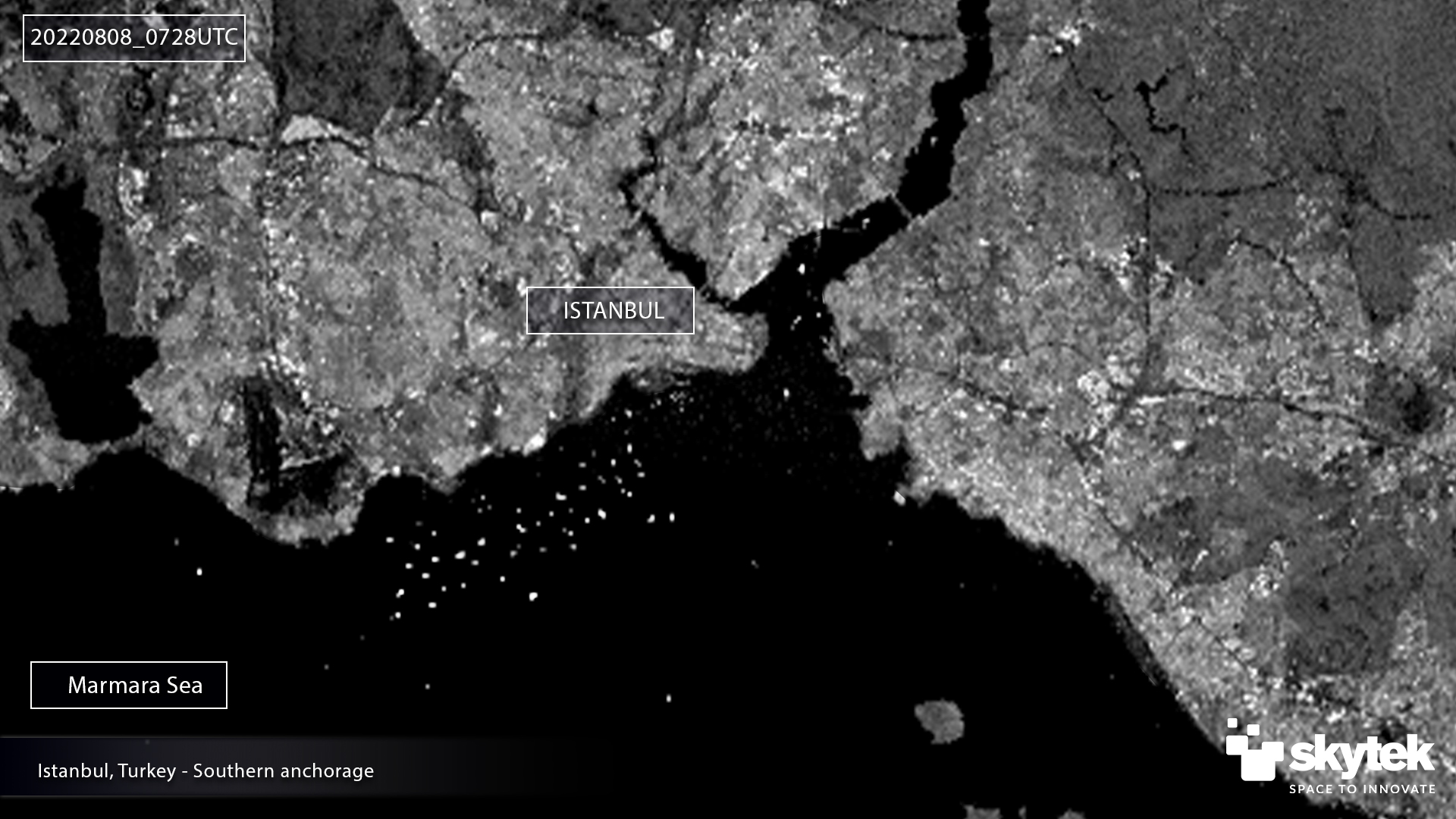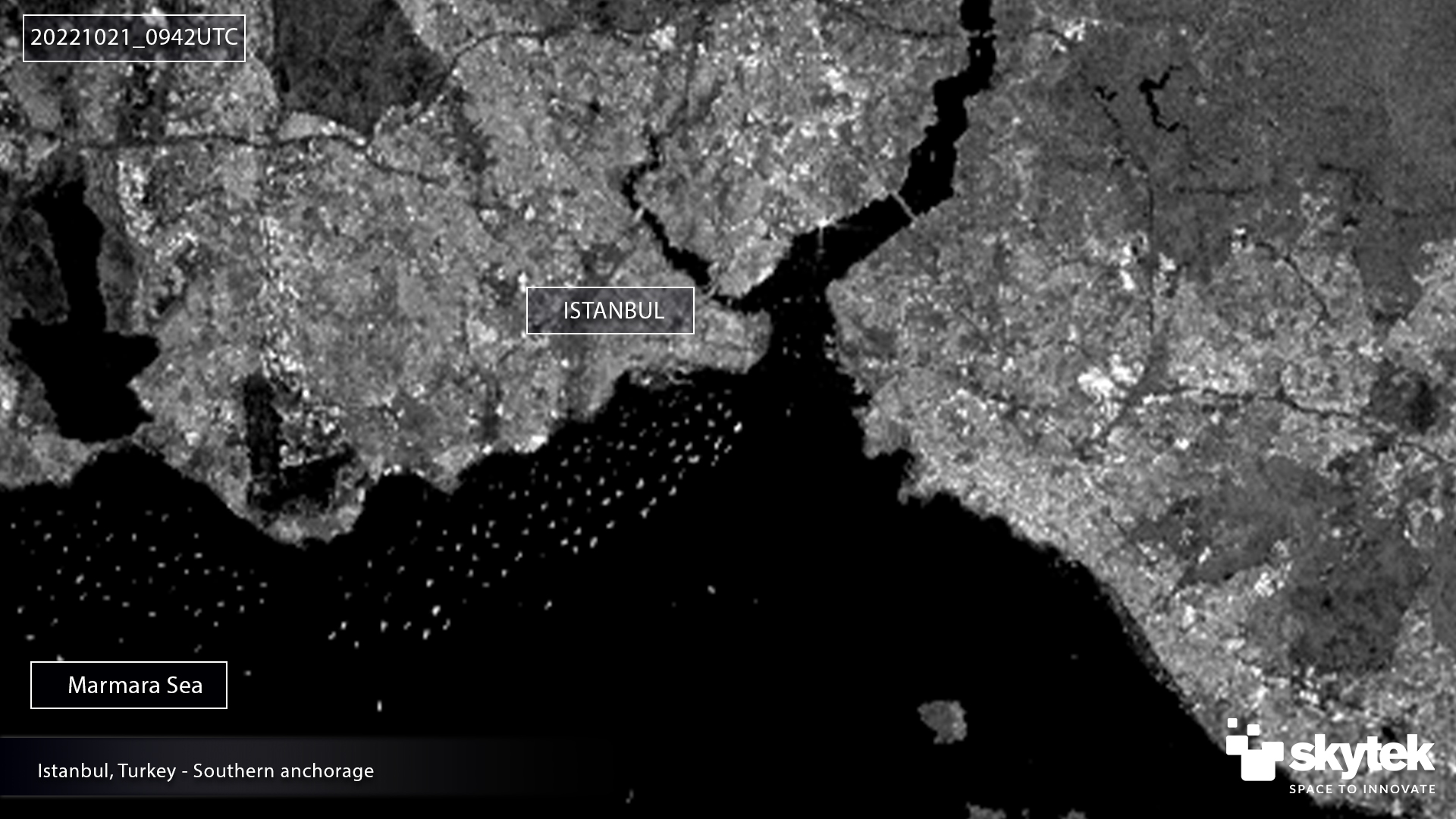Summary
The Bosphorus Strait is the narrowest strait used for international navigation, connecting the Black and the Marmara seas and separating Europe from Asia. Around 170 vessels transit each day and the waiting areas both North and South of the strait have always been congested, often ships having to wait hours or days before being planned for transit
CONGESTION IN BOSPHORUS STRAIT
Skytek’s analytics platform is constantly analysing congestion worldwide, which is noted to be spiking lately for the Bosphorus strait.
The number of ships anchored south of the Bosporus strait is rather constant for the first half of 2022, at around 65 ships.
On July 27th, 2022, the United Nations (UN) secretary general announced the establishment of the Joint Coordination Centre (JCC) to monitor the implementation of a UN initiative, to allow grain commercial food exports from three key Ukrainian ports in the Black Sea – Odesa, Chornomorsk, Yuzhny.
Between July 27th and October 27th, Skytek records around 340 unique ships transited the Bosphorus strait under the JCC agreement, with the large majority engaged in grain carriage, Bulk Carriers at 57.06% and General Cargo Ships at 28.24%. The remaining 12.94% is Oil/Chemical Tankers carrying edible oils, such as Rapeseed Oil, Sunflower Oil, or Soya bean oil cargoes.
Skytek has a full list of the ships that entered the ports of Ukraine, the type and quantities of cargo carried, and their intended destinations.
According to the JCC procedures, the ships intending to call at any of the three agreed ports, have to be inspected by a team of representatives from Ukraine, Russia and Türkiye at Istanbul before and after loading in Ukraine.
Although the physical inspection is expected to take 4-6 hours per ship, Skytek notes that the number of ships arriving at Haydar Pasa, the Istanbul Southern anchorage, and the average waiting time before a vessel is slotted to transit the Bosphorus Strait, have been increasing since July 27th, 2022.
MERCHANT SHIPS CALLING UKRAINE PORTS UNDER JCC AGREEMENT, OVERVIEW
Skytek analysed the set of ships engaging to carry food products under the Grain Corridor agreement. In Table 1 below, Skytek details the vessel type distribution for the vessels anchored South of the Bosphorus Strait. The Bulk Carriers and the General Cargo vessels are the majority of the vessels waiting at anchor, and it is evident that the number of ships waiting is increasing each month, many of them drifting South of the Bosphorus Strait when a safe anchorage spot is not available.
On August 08th there are 250 merchant ships at anchor in the Southern anchorage, increasing to 308 ships on September 17th and to 328 merchant ships on October 24th, 2022. The detailed distribution per ship type as recorded during the past three months is represented in Table 1:
Ship Type | Aug. 10th 2022 | Sep. 17th 2022 | Oct. 24th 2022 |
Bulk Carrier | 96 | 103 | 126 |
General Cargo Ship | 66 | 97 | 104 |
Chemical/Products Tanker | 39 | 43 | 46 |
Container Ship(Fully Cellular) | 22 | 25 | 23 |
Products Tanker | 11 | 22 | 10 |
Crude oil Tanker | 6 | 6 | 6 |
LPG Tanker | 2 | 3 | 4 |
Ro-Ro Cargo Ship | 4 | 4 | 4 |
Bunkering Taanker (Oil) | 1 | 4 | 4 |
Livestock Carrier | 2 | 1 | 2 |
Total Number of ships | 250 | 308 | 328 |
Table 1 – Number of ships waiting at Istanbul, distribution per ship type
The ships transiting the Bosphorus Strait during 2021 were 14,6 years old, on average, and the ships that registered with JCC under the Grain Corridor Agreement during the past three months have an average age of 20,1 years, as detailed in Table 2 below:
2021 | Aug. 2022 | Sep. 2022 | Oct. 2022 |
14.6 years | 18.8 years | 19.8 years | 21.6 years |
Table 2 – Average age of ships in the Grain Corridor Agreement
According to our records, the Standard Club provides insurance coverage to 12,35% of the Grain Corridor ships, British Marine Insurance to 7,65% and West of England to 7,06%, while 23,24% of the ships in the Grain Corridor do not have active insurance cover.
Port State Inspections records indicate that the Grain Corridor ships perform below global standards. Table 3 highlights roughly three times more detentions and deficiencies above the global averages,
For the ships which called at Ukrainian ports in the past three months, the Skytek database records 170 casualties, 98 of which being classified as “Serious”, which is higher than the global fleet average
Last Year Average Detention Rate | Last Year Average Deficiencies records | ||
Grain Corridor Fleet | 10.88% | Grain Corridor Fleet | 9.10% |
Global Fleet | 4.28% | Global Fleet | 2.80% |
Table 3 – Port State Control inspections of last year’s performance of ships under the Grain Corridor Agreement vs Global
CONGESTION IN BOSPHORUS STRAIT
The growth of the number of ships calling Ukrainian ports, the availability of inspectors and other factors reflected in a drastic increase in the waiting times for Bosphorus Strait transit.
For 2021, Skytek records an average waiting time of 16,2 hours, with the longest waiting time of 4,3 days, and an average of 65 ships waiting at anchor in the Bosphorus anchorages.
The vessels arriving from one of the three Ukrainian ports agreed under the JCC have to be physically inspected at either side of the Bosphorus Strait before being cleared to proceed to the discharge port.
The average waiting time from arrival at either end of the Bosphorus and departure to its destination, including the Strait transit, is reflected in Table 4 below, detailed by ship type.
Ship Type // month | August | September | October |
Bulk Carrier | 2.64 days | 9.58 days | 17.47 days |
General Cargo Ship | 2.56 days | 8.55 days | 17.71 days |
Oil/Chemical Tanker | - | 3.76 days | 11.41 days |
All ships average | 2.68 days | 8.93 days | 16.38 days |
Table 4 – Average waiting time at Bosphorus, Southbound, for ships registered with JCC for the Grain Corridor
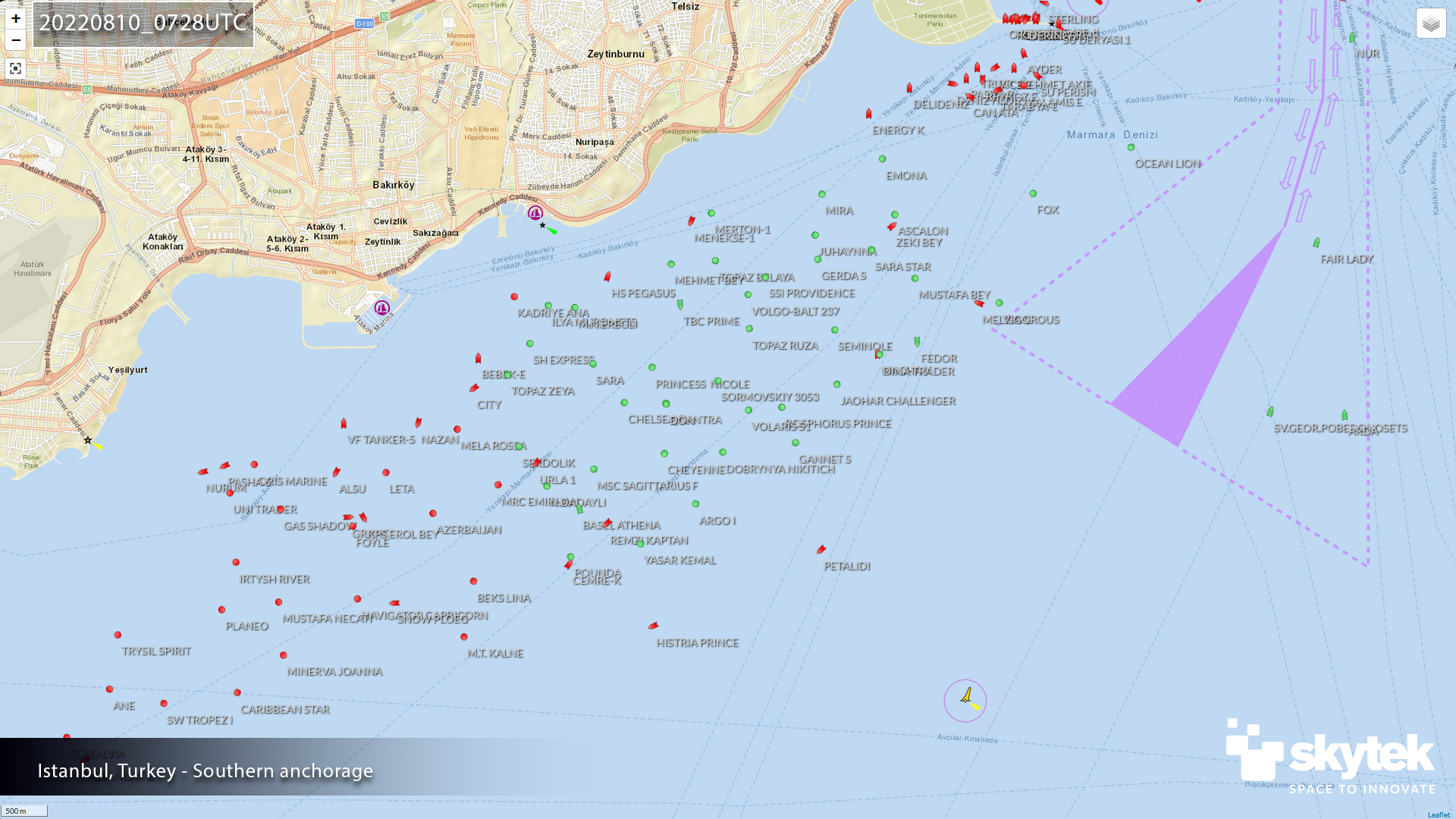
The 250 merchant ships on August 10th waiting at anchor to be cleared for Northbound transit are mapped in Figure 1 below:
The number of anchored merchant vessels increased to 308 on September 17th, as represented in Figure 2, and further to 328 anchored ships on October 24th represented in Figure 3.
An interesting aspect is that, as the number of ships is increasing, the average age is increasing and the Port State Control inspections performance is decreasing.
Vessels that transited the Bosphorus during 2021 had an average age of 14.6 years, but this increased to 18,8 in August 2022, 19,7 for September 2022 and 21,6 years in October 2022.
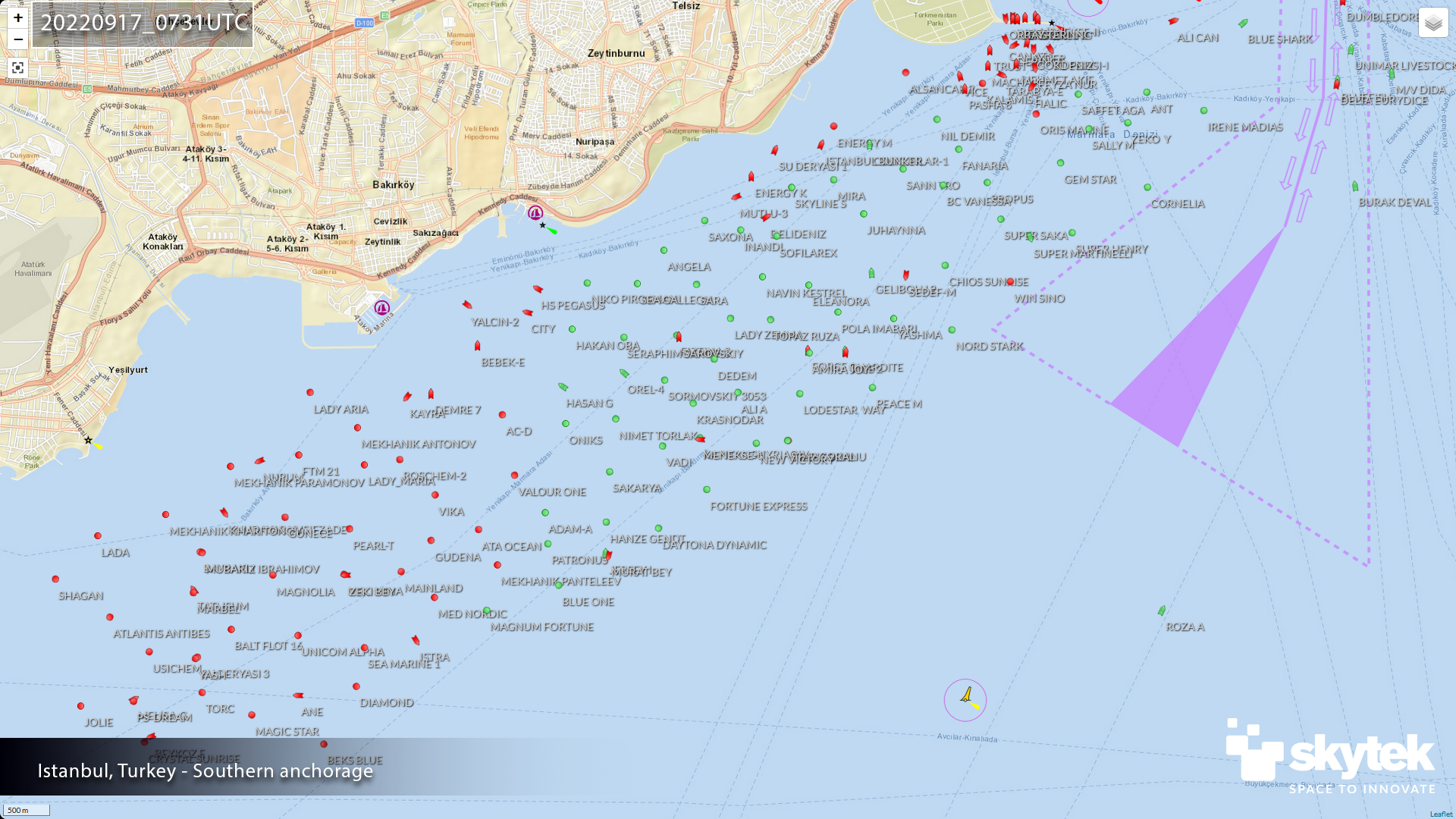
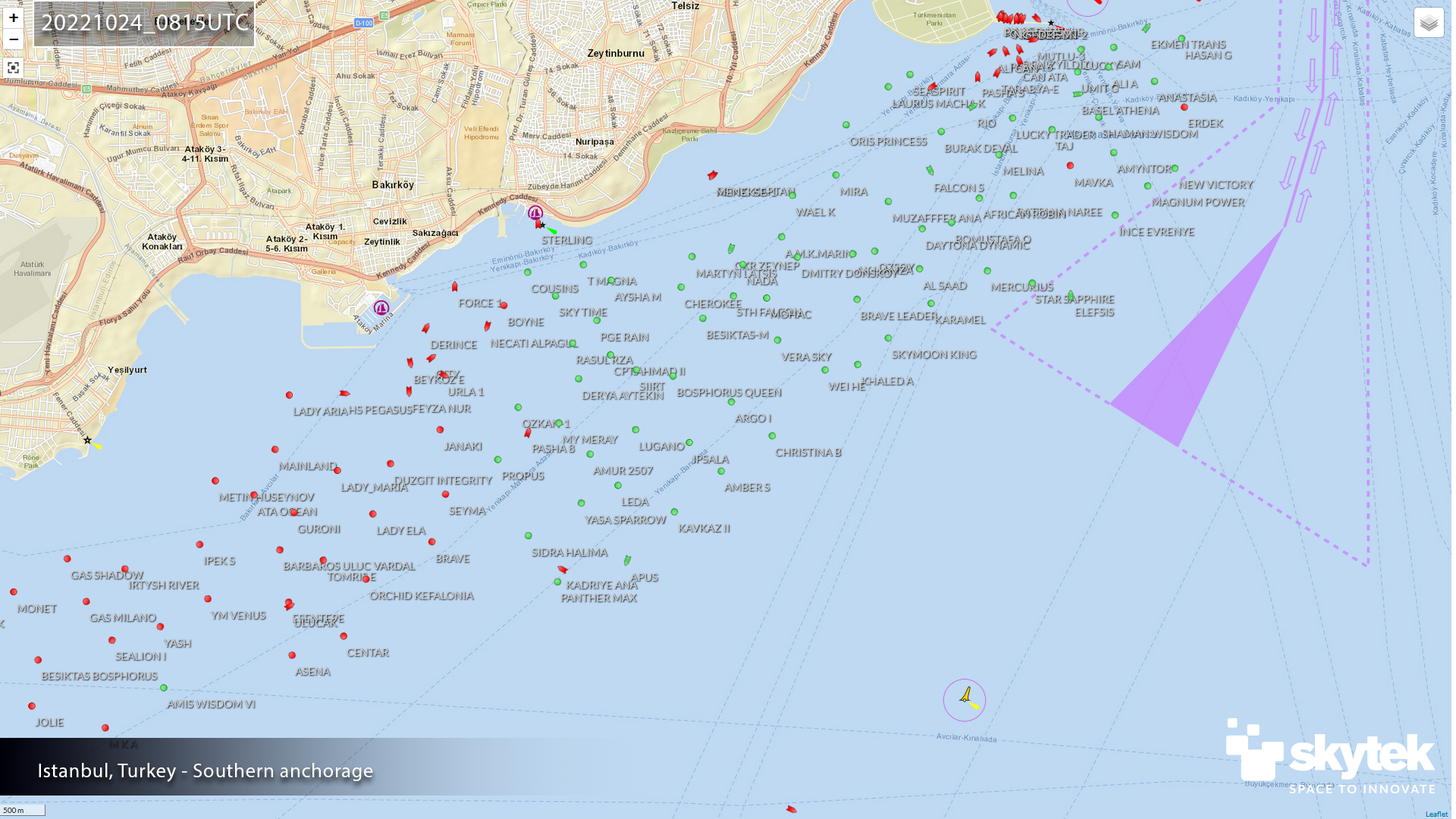
Using high-resolution Synthetic Aperture Radar (SAR) images, Skytek highlights the contrast to the high number of vessels captured in Figure 5 below:
MARITIME INCIDENTS IN THE BOSPHORUS STRAIT FROM AUGUST 2022 TO OCTOBER 2022
Skytek intelligence platform tracks the sailing patterns of the ships through the Bosphorus Strait and records several maritime incidents in the list below, which may be well related to factors highlighted in the platform, such as high-density traffic and congested navigation pathways:
- The Panama flag, 32,328DWT Bulk Carrier Lady Zehma – IMO 9303431 suffered a rudder failure and ran aground North of the Bosphorus Strait on September 01st, 2022. The vessel was refloated with tug assistance after several hours.
- The Malta flag, 8,152DWT Bulk Carrier Fox – IMO 9452452 suffered an engine failure at the southern entrance of the Bosphorus and was towed to a safe anchorage for several hours.
- The Liberia flag, 82,056 DWT Bulk carrier Tomahawk – IMO 973759 suffered an engine breakdown while transiting the Bosphorus Strait on September 08th, 2022. Tugs towed the vessel to Ahirkapi anchorage, South of Bosphorus Strait.
- The Greek flag, 53,688 DWT Bulk Carrier Annita – IMO 9282869 suffered an engine failure on October 13th in northern Bosphorus and was towed to a safe anchorage. Traffic was suspended for about four hours.
- The Panama flag, 5,788 DWT General Cargo Ship T-Moon – IMO 8917417 suffered an engine failure in the Bosphorus Strait on October 05th and was towed to northern Bosphorus to anchorage.
- The Panama flag, 53,800 DWT Bulk Carrier Viva Eclipse – IMO 9438016 suffered rudder failure in the Bosphorus Strait, northbound on September 28th, and was towed back to Marmara sea.
- The Cook Islands flag, 6,917 DWT General Cargo Briza – IMO 9286815 suffered a mechanical failure while transiting Bosphorus in the northern direction and had to anchor in emergency on September 03rd
- The Liberia flag, 35,648 DWT Product tanker JANAKI – 9259915 suffered engine failure while entering Bosphorus and was towed by tugs to Marmara sea, on August 14th.
- The Palau flag, 4,791 DWT General cargo ship Sun Unicorn – IMO 9178422 suffered engine failure shortly after exiting Bosphorus in the Black sea on August 17th.
- The Liberia flag, 115,156 DWT Bulk carrier Philipp Oldendorff IMO – 9540869 drifted onto anchored bulk carrier SSI Providence IMO 9883065 – at Ahirkapi Anchorage, Istanbul, in the evening of August 05th.
